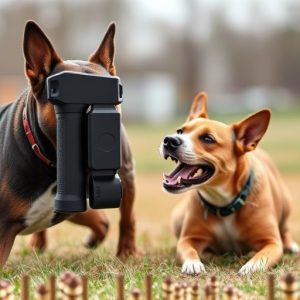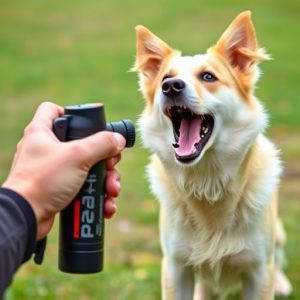Dog Spray & Capsaicin: Unveiling the Active Ingredient Composition
Dog spray effectiveness depends on its capsaicin content (0.5% – 2%), with higher levels offering st…….
Dog spray effectiveness depends on its capsaicin content (0.5% – 2%), with higher levels offering stronger, longer-lasting protection against aggressive dogs. When comparing dog sprays, understanding these percentages is crucial for tailoring defensive tools to specific canine behaviors, weather conditions, and safety concerns around children and pets. A thorough capsaicin content comparison aids in selecting the most appropriate dog spray for individual needs.
Mail Carrier Dog Spray: Protecting Both Canine Companions and Deliverers
In today’s world, mail carriers often encounter dogs, which can lead to potentially unsafe situations. Dog spray, an essential tool for these professionals, uses capsaicin to deter aggressive dogs. This compound is a natural ingredient known for its effectiveness in managing canine behavior without causing harm.
Our article delves into the world of dog spray, focusing on capsaicin content comparison. We guide you through understanding this powerful ingredient and selecting the right spray based on safety, effectiveness, and user feedback, ensuring a harmonious relationship between dogs, mail carriers, and their communities.
- Understanding Dog Spray and Capsaicin Content
- – Definition of dog spray and its purpose
- – Explanation of capsaicin and its role in dog spray
Understanding Dog Spray and Capsaicin Content
Dog spray, also known as pepper spray for dogs, is a non-lethal self-defense tool designed to temporarily incapacitate an aggressor. Its active ingredient is capsaicin, the same compound that gives hot peppers their heat. Understanding the capsaicin content in dog spray is crucial when comparing different brands and types. Capsaicin levels are typically measured in percent or milliliters per ounce, indicating its potency.
A closer look at the capsaicin content reveals a wide range across products. Lower concentrations may offer a milder sting, suitable for training purposes, while higher percentages provide stronger protection during potentially dangerous encounters. When considering a dog spray, it’s essential to balance effectiveness with safety, especially around children and other pets. A thorough comparison of capsaicin content allows owners to make informed decisions based on their specific needs and the temperament of their canine companion.
– Definition of dog spray and its purpose
Dog spray, also known as mace or pepper spray for dogs, is a non-lethal self-defense tool designed to temporarily incapacitate and deter aggressive canine behavior. It is a liquid or aerosol substance that contains capsaicin, the same compound found in chili peppers. When deployed, dog spray irritates the eyes, nose, and respiratory system of the target animal, causing them to temporarily become distracted and less aggressive. This gives the user an opportunity to escape or control the situation.
The capsaicin content in dog sprays varies significantly, with strengths ranging from 0.5% to 2%. A higher percentage indicates a stronger concentration, which can lead to longer-lasting effects but may also increase the risk of adverse reactions. When comparing different dog spray products, examining the capsaicin content is crucial as it directly impacts the product’s effectiveness and potential side effects.
– Explanation of capsaicin and its role in dog spray
Capsaicin, the active ingredient in chili peppers, serves as the powerful compound behind dog spray. This chemical irritates a dog’s eyes and respiratory system, causing them to temporarily incapacitate or retreat. Dog spray typically contains a higher concentration of capsaicin compared to other pepper-based products, making it an effective deterrent for unwanted canine interactions.
When comparing different dog sprays, understanding the capsaicin content is crucial. Manufacturers often list this information as a percentage of the product’s total volume. A higher capsaicin content generally translates to a stronger spray, offering better protection and longer duration against aggressive dogs. This knowledge allows pet owners and professionals alike to make informed decisions when choosing a dog spray that best suits their needs based on factors like intensity, weather conditions, and specific canine behaviors encountered.
In understanding dog spray and its capsaicin content, it’s clear that these products serve as effective deterrents for potential threats. A thorough comparison of different dog sprays reveals varying capsaicin levels, impacting their potency. When choosing a dog spray, considering the specific needs and environment is key. Whether for personal protection or training purposes, selecting the right spray with the appropriate capsaicin content ensures its effectiveness in various scenarios.


